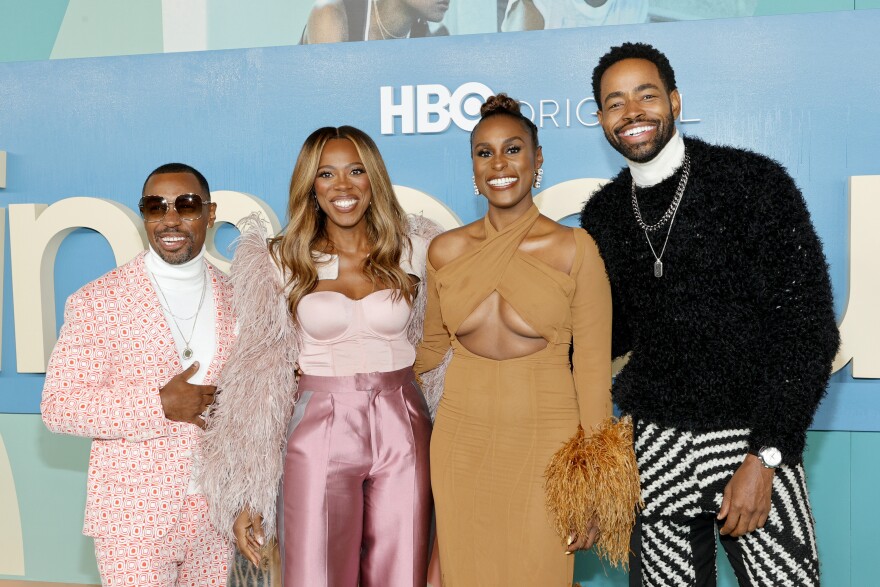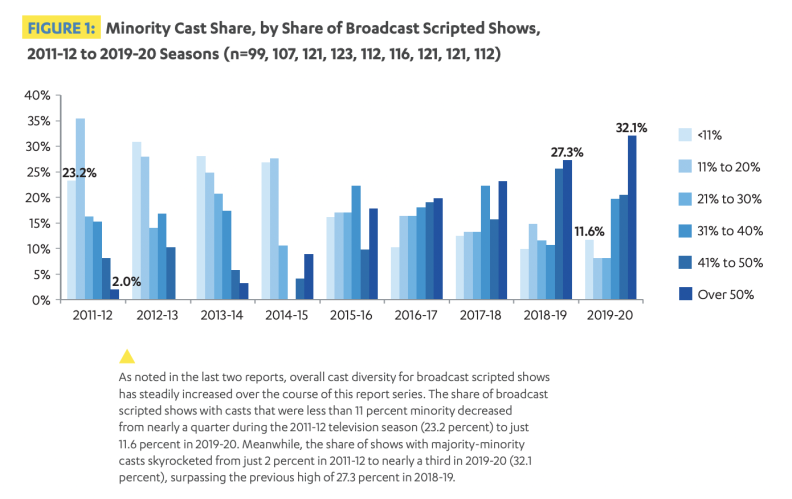With our free press under threat and federal funding for public media gone, your support matters more than ever. Help keep the LAist newsroom strong, become a monthly member or increase your support today.
Increased Representation On Screen Was Good For TV Business During Pandemic

If you were to watch some of the top series on streaming platforms and cable channels — Netflix’s “Bridgerton,” HBO’s “Insecure,” Hulu’s “Our Kind of People” and Amazon’s “The Underground Railroad”— you reasonably could conclude that Hollywood’s commitment to diversity was bearing fruit.
But if you then picked up your remote and surfed through some of the highest-rated network TV shows — CBS’ “Young Sheldon,” NBC’s “Chicago Fire” and ABC’s “The Goldbergs” — you might immediately say the exact opposite: nothing has really changed.
According to a new Hollywood Diversity Report from UCLA, you’d be right on both counts.
The report, which examined 461 scripted shows in the 2019-2020 TV season, found that people of color posted gains in nine of 12 job categories in front of and behind the camera relative to their white counterparts from the previous season.
Overall, however, women and people of color remain under-represented as lead performers, writers and directors relative to the U.S. population, of which more than 42% identify as people of color.
UCLA’s researchers found the gains in diversity, even when minimal, were not spread equally among content creators and distribution platforms. In lead acting roles, for example, fewer than a quarter of network TV shows cast a person of color, while the share for cable and streaming series was closer to a third.
Fewer than one in 10 network series was created by a person of color. Even though those figures from cable and streaming were better (20.6% and 14.7%, respectively), they still were far below their portion of the U.S. population.
As other studies have shown, diverse programs do good business. UCLA reported that every one of the top 10 broadcast shows in Black households and eight of the top 10 broadcast shows in white households featured casts that were at least 21% minority. And nine of the Top 10 broadcast shows for younger (18-19 year-old) Asian and Latinx viewers had the same or better cast diversity.
Latinx people, who make up more than 18% of the country, continue to be the most marginalized, in broadcast, streaming and cable series. Latinx actors had just 6.3% of broadcast TV roles, and only 5.5% in streaming. Latinx directors made only 5.4% of broadcast TV episodes, 3.5% of cable episodes, and 3% of streaming episodes.
Despite a lack of growth for Latinx actors, the overall proportion of people of color on screen has increased over time.
Nearly a third of broadcast shows in the latest study had majority non-white casts. Compare that to the first such UCLA study eight years ago, when the numbers for the 2011-2012 season was just 2%.

The report said that material change wouldn’t happen until top decision makers are more diverse; the two top Netflix executives, for example, are straight white men.
The report concludes: “Only when women and people of color are integrated into these defining spaces — and in meaningful proportions — will Hollywood truly solve its diversity problem.”
At LAist, we believe in journalism without censorship and the right of a free press to speak truth to those in power. Our hard-hitting watchdog reporting on local government, climate, and the ongoing housing and homelessness crisis is trustworthy, independent and freely accessible to everyone thanks to the support of readers like you.
But the game has changed: Congress voted to eliminate funding for public media across the country. Here at LAist that means a loss of $1.7 million in our budget every year. We want to assure you that despite growing threats to free press and free speech, LAist will remain a voice you know and trust. Speaking frankly, the amount of reader support we receive will help determine how strong of a newsroom we are going forward to cover the important news in our community.
We’re asking you to stand up for independent reporting that will not be silenced. With more individuals like you supporting this public service, we can continue to provide essential coverage for Southern Californians that you can’t find anywhere else. Become a monthly member today to help sustain this mission.
Thank you for your generous support and belief in the value of independent news.

-
What do stairs have to do with California’s housing crisis? More than you might think, says this Culver City councilmember.
-
Yes, it's controversial, but let me explain.
-
Doctors say administrator directives allow immigration agents to interfere in medical decisions and compromise medical care.
-
The Palisades Fire erupted on Jan. 7 and went on to kill 12 people and destroy more than 6,800 homes and buildings.
-
People moving to Los Angeles are regularly baffled by the region’s refrigerator-less apartments. They’ll soon be a thing of the past.
-
Experts say students shouldn't readily forgo federal aid. But a California-only program may be a good alternative in some cases.







